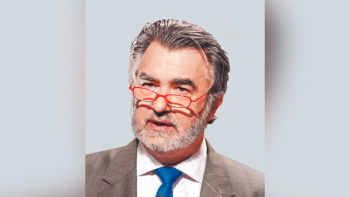
Defining Decentralized Clinical Trials
Craig Lipset, Co-Chair of DTRA, discusses the evolving nature of decentralized clinical trials and DTRA’s initiatives.
Decentralized Clinical Trials (DCTs) have evolved from concepts into a much more structured approach within the biopharmaceutical industry. The concept has become so significant that collaborations, such as Decentralized Trials and Research Alliance (DTRA), have emerged with strong support from industry leaders to help provide guidance and clarity around DCTs and industry best practices. In this interview, Craig Lipset, Co-Chair of DTRA, will discuss the evolving nature of DCTs and DTRA’s initiatives.
Moe Alsumidaie: What prompted you to found DTRA?
Craig Lipset: The genesis for DTRA dates back before the pandemic. At that time we had many conference panels related to decentralized clinical trials where leaders were coming together, sharing some fabulous ideas and opportunities, but then would all head back to their day jobs and leave all those opportunities on the table until we came back together at the next conference to pick up those conversations. DTRA Co-chair Amir Kalali and I believed there was need for a space for those conversations to develop and ultimately create solutions together, which gave rise to DTRA.
MA: Are DCTs clearly defined, or are we in the beginning phases of defining DCTs?
CL: When you look at existing initiatives like the Clinical Trials Transformation Initiative and IMI Trials@Home, you start to see some consistent themes for DCT definitions. These definitions tend to include the use of technology and/or innovative processes that enable visits outside of a conventional research site. So, this is about technology such as those that can allow self-reporting of data, sensor-derived data, the use of video, and so on. And it's also about process changes, such as the use of home health and visiting nurses, acquiring labs locally, drug distribution to the patient's home, the possibility of administering medicine in the patient's home, or even configuring centralized or “meta” sites. It's not just a tech play; It can also be a heavy process play, and the desired state is to create options for people in how they engage, not necessarily forcing everything in the home because that's not right for every patient.
You tend to see many of those words resonating in terms of how people define this. But when a study team goes into Google and searches for a decentralized trial provider, it still turns into chaos. You wind up with a list of very different solution providers, which becomes extremely hard for study teams to navigate. Who is doing what? What collection of solution providers do I need to support my study today? Many of the large pharma have gone from late last year relying almost exclusively on their CROs to serve as their general contractor and navigate various solutions, to now having sponsors navigating that space and selecting specific partners for different DCT-related capabilities. I think for a lot of small and midsized pharmas, though, it's still a very confusing ecosystem to have to navigate.
MA: What is the current state of DCTs?
CL: I think this is an exciting time for decentralized research, but it is a crucial time for us to leverage organizational momentum and enthusiasm to create sustaining commitments in these areas, making sure that our organizations are ready to continue to adopt at scale and ensuring we're learning from the experiences that are going on today to help to optimize our processes in the future. Solutions close to the center of the decentralized universe include many that sponsors have been doing for years: ePRO and eCOA. Many have already been doing visiting nurse and home health. Decentralized builds and expands on these competencies. So, organizations don't have to look at this as foreign and intimidating. Incremental counts and every step forward is an important step.
And so, where decentralized is now increasingly accepted as a competency, what innovations continue to grow and expand this core? It's an exciting time in that there is an established ecosystem of solution providers today, but that ecosystem continues to grow with new and creative innovators coming up with novel approaches to wrap around today’s DCT environment. And that's been very exciting to see, and I encourage folks out there to treat this as an opportunity for incremental expansion.
MA: What methodology is recommended to build a DCT infrastructure?
CL: What you see today are sponsors that have gone through a disciplined process of looking internally at their portfolio and future study needs. Based on those portfolio needs, they are then identifying which decentralized research methods their study teams will need to be able to access, finding new partners if they don't exist in their network, reviewing SOPs and training to make sure that those solutions can fit in their operating environment, reviewing protocol templates and other tools, and making sure that culture-wise the organization is ready to engage. The next step is then to be able to pair each study with the right decentralized research methods.
Some people may say, "we should use a clinical decision support tool.” Ideally a team should be able to input their protocol and have a data-driven process to find the right decentralized tools to make a successful study. Unfortunately, we don't have the body of data and evidence yet to power that. Until that body of data grows we have human processes that look at regulatory intelligence based on the countries in which you're operating, the safety profile of the investigational product and how it's administered, patient input and insights, and a host of other factors to try to infer which solutions are suitable for which study. Some large pharmas have put in place internal subject matter expert-driven teams to help advise study teams on this. More often than not, the rate limiter for those solutions is driven by cultural constraints within the organization. Cultural aspects include whether teams are supported, or do they feel constrained in how much they can do? How much change could they embed at one time? That tends to be the process today, and that works well for large pharma, but it still is hard for small and some mid-sized pharmas, who need to rely much more heavily on their CROs and other partners to help them navigate that landscape and make good decisions on which solutions to include.
MA: How will DCTs impact study sites?
CL: Once upon a time, a lot of the jargon people were hearing was that studies would evolve from brick and mortar to a hybrid middle state to some desired future state of being fully remote and fully decentralized. And in many ways, that's the technologist's view of the world. However, the reality is that when you talk to patients and research participants the sentiment about a research site is exceptionally high. The average site rating on TrialJourney is 4.4 out of five. When we look at data from CISCRP, perception of their experience at sites is overwhelmingly favorable. The challenge in clinical research studies is not that patients don't like their sites; it’s that they can't always get there. And so when we focus on access as being the challenge, we tend to land more often than not on hybrid studies, not as being a fuzzy middle ground, but being the desired end state for many studies.
Today’s desired future state for many is to enable participants to have more choice and flexibility on a visit-by-visit basis, powered by endpoints and measurement approaches that capture high quality data agnostic to location., In this desired future if a patient wants to go to a site, we do not deny that to anybody, but if they can't, we have other options available based on their individual needs. So, given that future state, sites will continue to play an essential role in research conduct and participant experience. Organizations like SCRS were also very thoughtful in ensuring that the sites had a clear role to play and a pathway for them to start engaging with the use of video to support patient visits, even before the pandemic.
The ability for different types of sites to invest in training and tools to support decentralized trials will vary greatly. We may start seeing separation among different in terms of their ability to invest in the state of readiness for DCTs. I suspect that more and more sites, especially more extensive networks, will take greater ownership over many of the tools and approaches in DCT. For example, will some site networks or academic-based sites make home visits for their partiicpants an internal capability? Can sites invest in their own DCT-supporting technology, such as eConsent or video visits? And can sponsors focus less on pushing less unfamiliar study-specific technology to the site, and instead start to focus on minimum quality standards and interoperability? As we see more of that, it may create some differences among different profiles of sites and how much they're able to do there. As these opportunities emerge, we will need to make sure all sites can be supported so that those unable to invest are not left behind.
MA: What are DTRA’s priority initiatives?
CL: DTRA is a member organization. One of our first tasks in bringing these leaders together was to define a discreet set of priorities for the organization, and our members defined four. The first is toward a clear set of definitions and language. The second is around best practices and our ability to learn from recent experiences. The third is education and using data and evidence to grow this community. And the fourth relates to those remaining barriers to global adoption and how we can start to address those together.
We then defined a collection of initiatives beneath each of those four priorities. And today, there are 12 initiatives across these four priorities supported by DTRA members. For example, some initiatives create pathways for us to aggregate and share evidence of the impact of decentralizing and use that as a foundation for curricula and other types of education and training. TSome are creating platforms that allow us to track regulatory intelligence and additional insights globally to help study teams and operators understand the global landscape related to DCTs. We share details on all 12 initiatives and their progress at DTRA.org, and all of the work product is meant for the public domain to improve the global research environment. So, there's a wide range of initiatives right now that collectively are meant to ease the global implementation of DCTs for our community and the community at large.
Moe Alsumidaie, MBA, MSF, is a thought leader and expert in the application of business analytics toward clinical trials, and Editorial Advisory Board member for and regular contributor to Applied Clinical Trials.
Newsletter
Stay current in clinical research with Applied Clinical Trials, providing expert insights, regulatory updates, and practical strategies for successful clinical trial design and execution.




